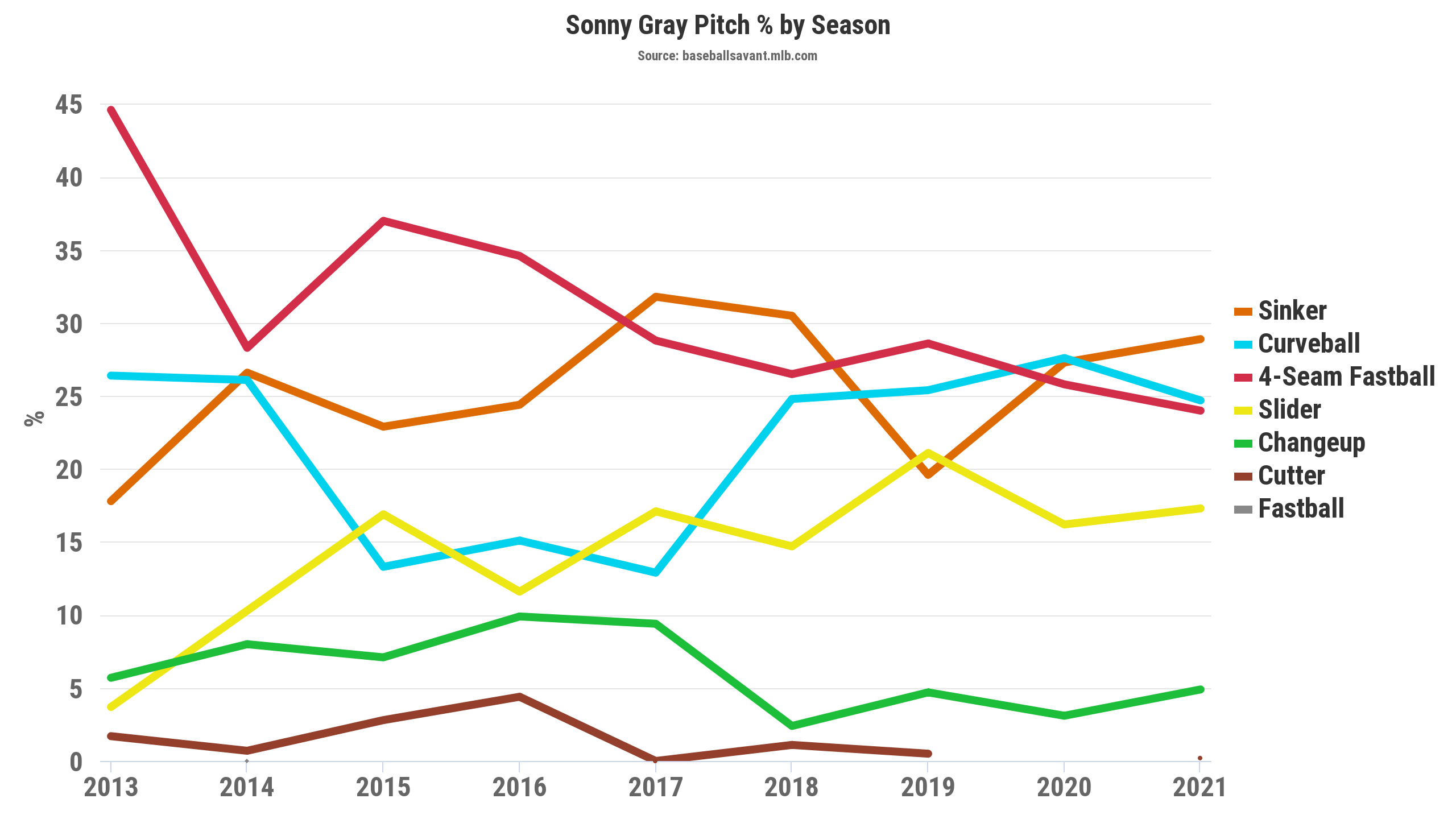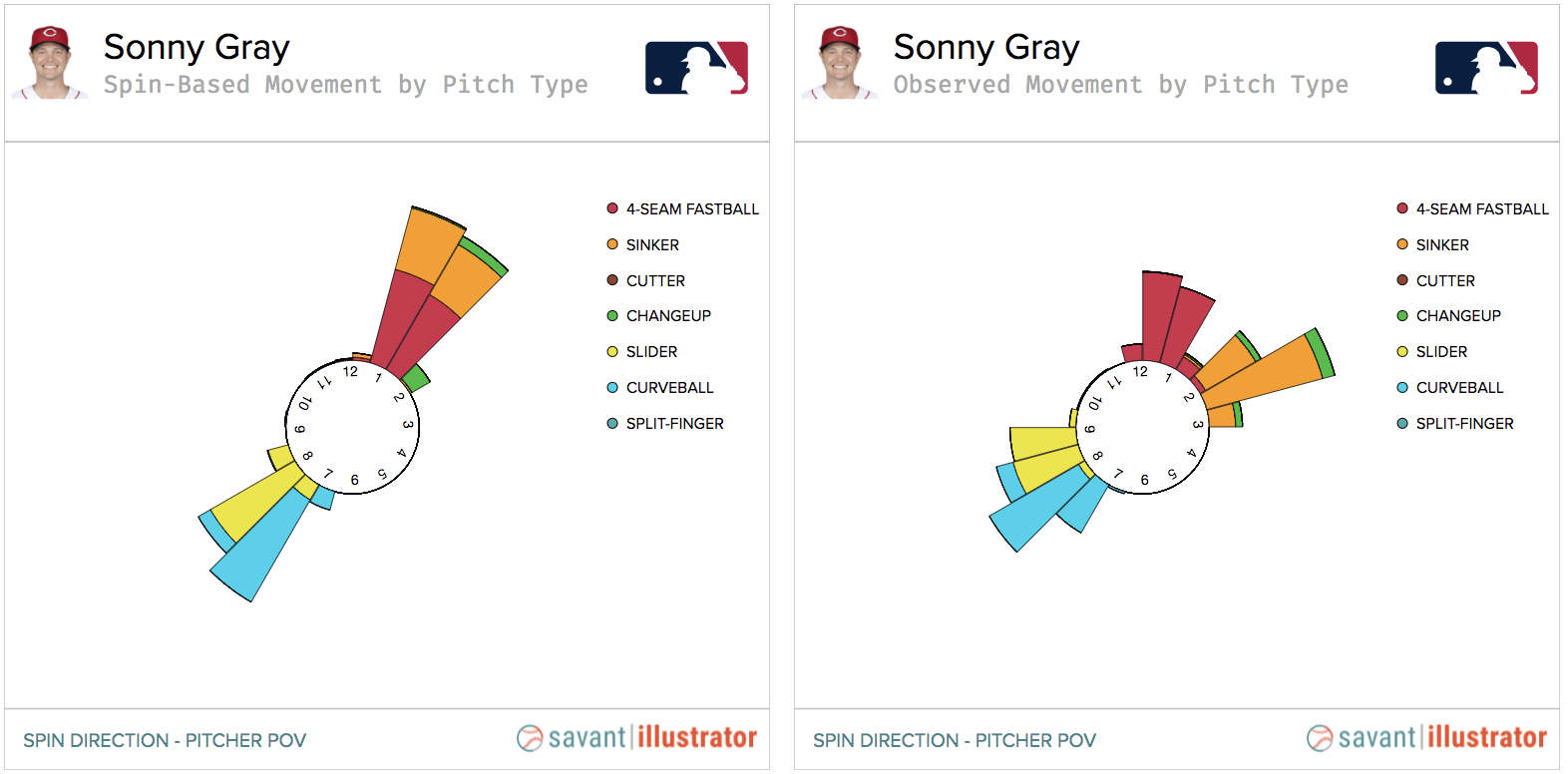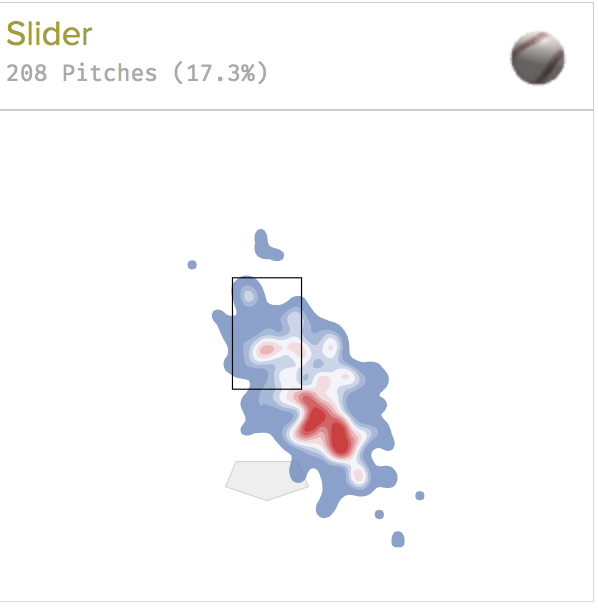There have been three major phases to Sonny Gray’s career. As an Oakland Athletic, he was once one of the best pitchers in all of baseball, finishing in the top three in Cy Young voting one year. After a trade to the Yankees, Gray could not live up to the expectations in the Bronx. Soon after, Gray rejuvenated his career with the Reds, putting together two (really one and 1/3) very good seasons. In 2021, as everyone began to buy back in, his numbers have dropped off again. Ironically, Gray has never had a season with an ERA between 4.00 and 4.50, the range where league average typically falls. He has always either been above or below. I understand the frustration, but this may not be as bad for Gray as it may seem.
Pitch Usage Dilemma
Gray has four good pitches that he uses at nearly equal frequencies. His success has always been dependent on how he mixes them up. His career pitch usage chart is, to put it lightly, a mess.
 One of the theories behind Gray’s struggles as a Yankee was his increased reliance on his sinker. In his first season with Cincinnati, he immediately dropped the sinker’s usage. Now, in 2021, it’s back up to 2018 levels. Not that it necessarily means anything, but his sinker usage rate correlates pretty well with his performance.
One of the theories behind Gray’s struggles as a Yankee was his increased reliance on his sinker. In his first season with Cincinnati, he immediately dropped the sinker’s usage. Now, in 2021, it’s back up to 2018 levels. Not that it necessarily means anything, but his sinker usage rate correlates pretty well with his performance.
Gray’s spin direction profile is among my favorites to look at.

His four-seam fastball and sinker appear to be spinning in the same direction at his release point, but obviously, end up in different spots. The same can be said about his slider and curveball. Not only that, the fastballs and breaking balls are near direct images of each other, which makes it even more difficult for batters to decipher the pitch type.
The Breaking Stuff
Not many pitchers will consistently attack you with two different breaking pitches, but Gray does it effectively and they each have their own separate benefits. His high-spin curveball is primarily used to drop in for called strikes. He generates an impressive 32.7% CSW% on such pitches. On the other hand, the slider is where he generates his whiffs out of the zone:

This heat map shows how frequently he throws his slider out of the zone. Batters have swung at 40.4% of sliders thrown by Gray, despite the pitch having just a 28.4% zone rate. It would not be as effective without the existence of his curveball. And vice versa, too. Since both pitches appear so similar at release, batters tend to chase sliders and take hittable curveballs more frequently than they typically would.
The Fastballs
I’ve seen many advocating for Gray to ditch either his sinker or four-seamer and just roll with one fastball. However, both pitches have their own purpose. Similar to his breaking pitches, they appear similar and are difficult for batters to decipher. This goes back to the idea that Gray’s sinker (or lack thereof) is a major factor that determines his success on the mound. It makes sense. Gray has thrown his sinker 29.2% of the time in 2021, which is good for his most commonly thrown pitch. The last time this was the case? You guessed it, 2018 as a Yankee. The pitch has a +2 run value against, the worst of his four major pitches. Against right-handed hitters, his sinker usage goes all the way up to 45.6%. It’s probably no surprise to find out he has allowed a .436 wOBA against righty batters.
But let’s pump the brakes for a second. This is really only the first time in his career his sinker has had results this poor. It has traditionally been a reliable ground ball pitch. Its 62.5 GB% in 2021, while still impressive, is lower than it has been. If you look at his career resumé, it’s the four-seamer that looks like the pitch he struggles with. In 2017-2019, his four-seamer carried a combined RV against of +21, at a rate of +0.98 RV/100. That’s not to say he should ditch the pitch altogether — it does carry a 30% CSW rate on the year, and is finally at a negative run value — but it does seem to be the weakest of his four pitches.
As always, correlation does not imply causation. Just because he has performed better when using his sinker less doesn’t mean he is performing better as a result of using his sinker less. All four of his pitches have a purpose and it comes down to balance and pitch sequencing.
Effects of the New Rule
Characteristically, MLB completely changed the game when they decided to start enforcing the rule against foreign substances. Many pitchers, Gray included, have seen massive drops in their spin rate since the decision.


However, as previously alluded to, his four-seam fastball has looked pretty good this year. It ranks in the 76th percentile in spin rate, despite below-average velocity. The most notable pitchers affected by the new rule are guys who primarily thrive off high-spin, high-velocity, elevated four-seam fastballs, like Gerrit Cole or James Karinchak. Gray does like to keep his four-seamer up in the zone, but it’s far from his bread and butter. Either way, Gray needs to adjust his game to the new rule. Given his intelligence and the coaching staff that fixed him in the first place, I have confidence that he will.
Why are his Results Bad?
A pitcher who relies on ground balls is generally going to see noisy results. Ground balls are good but sometimes they find holes. It is concerning to see Gray’s ground ball rate down (and fly ball rate up). However, the difference is probably not large enough to assume any significance. His 14% FB rate in 2020 seems like a pretty clear outlier. His hard-hit rate against is at a career low and his weak contact rate against is at a career high, which, for whatever they’re worth, is good.
If you did a deep dive on Gray’s 2021 season and ignored his ERA, you’d probably conclude he’s had a good season. Regression to the mean is inevitable. I expect a return to the Sonny Gray we are used to seeing. We already saw it in his most recent outing. If someone in your league, dynasty or redraft, is looking to trade Sonny Gray, now is a perfect time to buy low.
Photos by Brian Rothmuller/Icon Sportswire and Joshua Reddekopp/Unsplash | Adapted by Ethan Kaplan (@DJFreddie10 on Twitter and @EthanMKaplanImages on Instagram)

